Among the most diverse devices created for pumping all kinds of liquids, the centrifugal pump turned out to be the most practical: the principle of operation of this unit provides a combination high performance and good pressure, but at the same time allows you to make the design extremely simple.
Most household pumps and pumping stations used for irrigation summer cottages and organizations autonomous water supply in private homes, belong to this type.
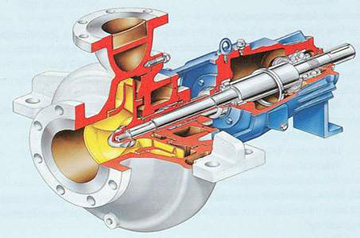 The working part of a centrifugal pump in the simplest version consists of a housing that looks a bit like a spiral or a volute, a shaft located inside it and an impeller mounted on this shaft.
The working part of a centrifugal pump in the simplest version consists of a housing that looks a bit like a spiral or a volute, a shaft located inside it and an impeller mounted on this shaft.
The transmission of rotation from the shaft to the wheel is carried out by means of a key.
The impeller consists of two disks and several blades fixed between them. The shoulder blades are curved and turned with a convex side in the direction of rotation.
The pump housing is made of steel or cast iron, the impellers in many models, especially those intended for domestic water supply, are made of polymers.
The impeller shaft can be both double-bearing and cantilever. Bearings are installed in the support units.
The shaft shank comes out of the housing and is connected by means of a coupling to the rotor of an electric or diesel engine crankshaft acting as a drive.
The hole in the pump housing, through which the shaft end passes, is sealed to prevent leakage of the pumped substance.
When choosing a centrifugal pump, it is better to give preference to models with a mechanical shaft seal. It is more reliable than gland packing, which is considered obsolete. In addition, the mechanical seal will be able to ensure the tightness of the housing even when the impeller shaft is displaced or vibrations.
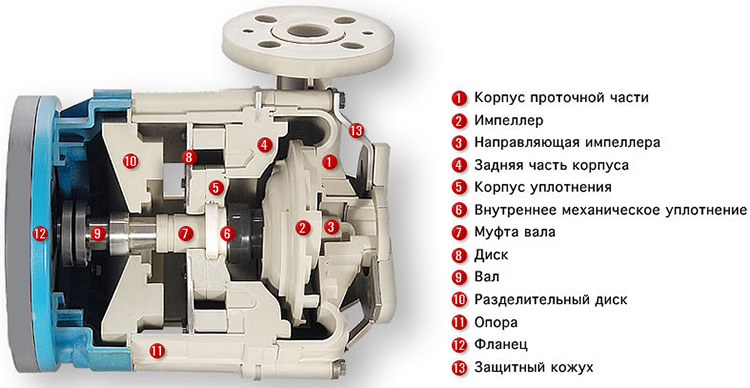
Centrifugal pump device
Water or other medium enters the working chamber of the pump through an opening in the center of the front of the housing. Its injection is carried out through a smooth outlet in the upper part, which gives the body a resemblance to a snail.
In addition to the main parts (housing and drive), which actually represent the pump, the delivery set includes elements without which the operation of the unit would be difficult or even impossible:
- mesh filter;
- check valve for the suction line;
- gate valve (installed in front of the suction pipe);
- vacuum gauge (allows you to control the degree of vacuum at the inlet to the working chamber).
If the pump you are purchasing is to be used to supply potable water, you must ensure that all parts that come into contact with it are made of appropriate materials. The case in this case must be made of high quality of stainless steel, impeller - also made of stainless steel or food grade plastic.
Quite in demand are models with a case made of ordinary, "non-food" material, inside of which a stainless steel insert is installed.
Such a unit will cost less than a completely stainless one. It will also cost less to repair: instead of restoring the case, it will be enough to replace the worn liner.
Operating principle
After starting the drive motor, the pump shaft with the wheel mounted on it begins to rotate. The blades of the wheel make the substance in the working chamber also rotate.
As soon as the liquid begins to move in a circle, it is subjected to centrifugal force directed from the center. Moreover, the module of this force is the greater, the farther the molecules of the pumped medium have shifted from the center of rotation.
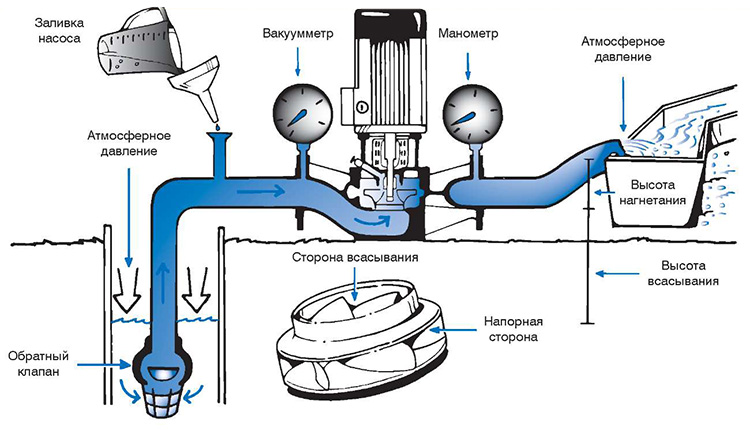
The principle of operation of a centrifugal pump
In the end, the liquid is ejected to the periphery of the impeller, and then into the upwardly curved outlet pipe. Thus, the pressure or, as they say, the pressure in the discharge line is maintained by centrifugal force.
Classification
Pumps of this type can be classified according to a number of criteria.
By number of steps
- single stage: have only one impeller. This design, considered classical, has been described in detail above.
- Multistage: such pumps are used when it is necessary to develop a significant pressure. They have several impellers mounted on a common shaft. The principle of operation of a multistage centrifugal pump: each wheel, together with its working chamber, forms a stage. The pump housing is designed in such a way that water or other liquid sequentially passes from one stage to another until it reaches the outlet. In this case, the pressure with which it is supplied is equal to the sum of the pressures developed by each stage.
In the direction of the axis of rotation
- Horizontal Shaft: The most popular type due to ease of maintenance.
- WITH vertical arrangement shaft: these pumps require less space for mounting, since their engine is located above the body. Most of the same type borehole pumps who have to work in rather cramped conditions. The disadvantage of this design is that the engine often has to be removed to repair or service the housing.
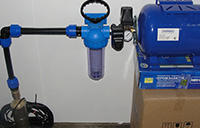 To provide autonomous water supply most often purchased submersible pumps. When choosing a unit, it is important to consider safety parameters. In this plan the best option will . Automation will provide protection against dry running, power surges, which will guarantee long-term operation of the equipment.
To provide autonomous water supply most often purchased submersible pumps. When choosing a unit, it is important to consider safety parameters. In this plan the best option will . Automation will provide protection against dry running, power surges, which will guarantee long-term operation of the equipment.
Why pumps are needed to increase water pressure, read.
If you need to deliver water from a well to a house for drinking or for watering a garden, then the Brook pump will suit you. Even though it is not very powerful, it will cope with such minimal functions, and you will win in price. Here you will learn all about the characteristics and operation of the pump.
By installation method
- Surface: placed near the source or at some distance from it. They are the cheapest, are constantly in sight, easily accessible for visual inspection and maintenance. Disadvantage: the water level in the source must be at least 8 m relative to the level of the pump installation, therefore, such units cannot work with deep wells or wells.
- Semi-submersible: vertical shaft pumps. They are installed so that part of the body is immersed in the source. Most often used for pumping liquid substances from pits.
- Submersible: in wells with great depths and wells, pumps are used that, being suspended on a cable or chain, are completely immersed in water.
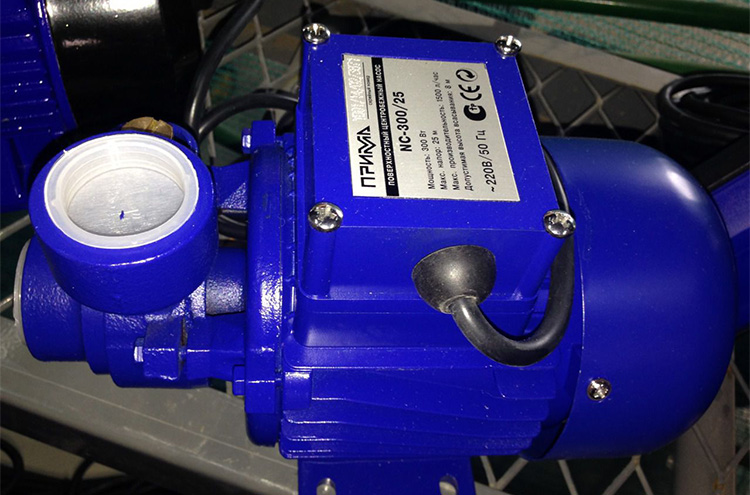
Surface centrifugal pump of domestic production
In order for the latter method of operation to be possible, the unit must meet several requirements:
- all external elements must be resistant to corrosion;
- not only the case, but also the electrical part must be sealed;
- pump design and build quality must completely exclude engine oil leakage, the removal of which from a well or well is very expensive.
It is clear that under such conditions a submersible pump is more expensive than a surface pump, but it is impossible to raise water from a great depth in any other way.
Owners of shallow wells (up to 25 - 30 m) can be recommended a compromise that combines the advantages of surface and submersible models.
We are talking about pumps with a remote ejector. The pump itself is installed at the top, which is very convenient, and its part - the ejector - is lowered into the well to a great depth.
According to the method of water intake
- Normal Suction Pumps: this type includes all submersible pumps, as well as some of the surface pumps into which water flows by gravity (for example, when pumping water from a tank with a tap located below). Before the first start-up, the cavity of the unit must be filled with water, in the future you can no longer worry about this.
- Self-priming: this is the name of pumps that can lift water from a certain depth. Theoretically, it is 10.34 m, but in practice it does not exceed 8 m. The self-priming pump has to be filled every time after a relatively long downtime, and not only the cavity of the unit, but also the suction hose must be filled with water. The latter must have reinforcement that prevents its compression due to rarefaction.
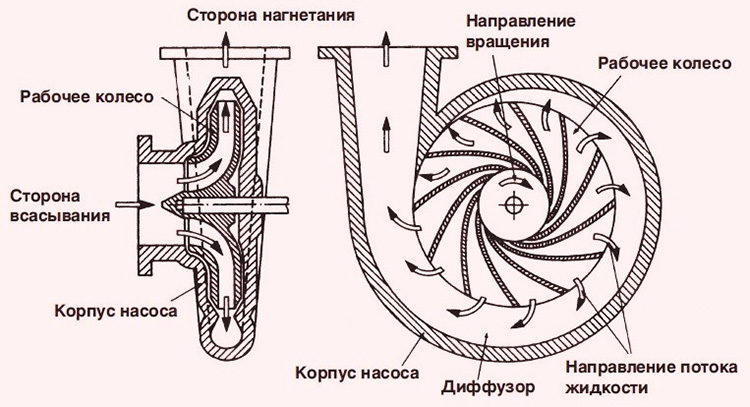
Self-priming water pump - principle of operation
launch self-priming pump and its operation in intermittent mode would not be possible without the most important element - check valve on the suction line. During filling and during short pauses in the operation of the unit, it retains water, preventing the water column from breaking.
Not all household pumping stations have this mechanism. Thus, a tempting offer with a price “lower than others” may turn out to be a catch.
According to the location of the inlet and outlet pipes
- Classic: the suction and delivery pipes are located as described above: the first is in front (in the center), the second is on top.
- In-Line pumps: differ from conventional models in that both nozzles (suction and delivery) are located on the same axis.
For pumping toxic, chemically aggressive and other hazardous substances another variety is used - sealed centrifugal pumps. They are designed in such a way that leakage of the pumped substance becomes absolutely impossible.
There are two types of performance:
- The engine is located inside the housing, and the impeller is mounted on its shaft.
- The motor and absolutely hermetic housing are made separately, and the torque is transmitted to the impeller by means of a magnetic coupling.
Characteristics of centrifugal pumps
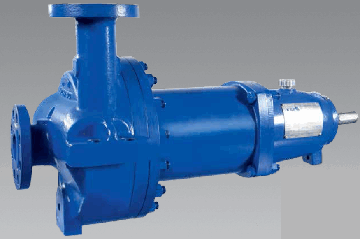 The operating parameters of the pumps are:
The operating parameters of the pumps are:
- power consumption (W);
- productivity (cubic m / h or l / min);
- outlet pressure, usually referred to as head (measured in meters of water column, abbreviated - m.w.st.).
A feature of centrifugal pumps is that their performance depends on the pressure.
How more pressure it is necessary to develop a unit for lifting water to a great height or “pushing” it through a long pipeline with high hydraulic resistance, the less volume of water it can pump per unit of time.
The basic equation of a centrifugal pump for the first time in the general view was received in 1754 by L. Euler and bears her name.
Considering the movement of fluid inside the impeller, we make the following assumptions: the pump pumps an ideal fluid in the form of jets, i.e., there are no all types of energy losses in the pump. The number of identical pump blades is infinitely large (z = µ), their thickness is zero (d= 0), and the angular speed of the impeller is constant (w= const.).
To the impeller of a centrifugal pump with a speed Vo, the liquid is supplied axially, i.e., in the direction of the shaft axis. Then the direction of the liquid jets changes from axial to radial, perpendicular to the axis of the shaft, and the speed due to centrifugal force increases from the value V1 in the space between the blades of the impeller to the value V2 at the outlet of the impeller.
In the interblade space of the impeller during the movement of fluid, absolute and relative flow rates are distinguished. Relative speed flow - speed relative to the impeller, and absolute - relative to the pump housing.
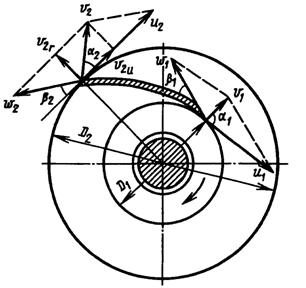
Rice. Scheme of the movement of fluid in the impeller of a centrifugal pump
The absolute speed is equal to the geometric sum of the relative speed of the fluid and the circumferential speed of the impeller. The circumferential velocity of the liquid exiting between the vanes of the impeller coincides with the circumferential speed of the impeller at a given point.
Circumferential fluid velocity (m/s) at the impeller inlet
Circumferential velocity of fluid at the outlet of the impeller (m/s)
Where n-impeller speed, rpm; D1 And D2- internal and external diameters of the impeller, m, w- angular speed of rotation of the impeller rad/s
When the impeller moves, fluid particles move along the blades. Rotating together with the impeller, they acquire peripheral speed, and moving along the blades - relative.
The absolute velocity v of fluid movement is equal to the geometric sum of its components: relative velocity w and district u, i.e. v = w + i.
The relationship between the velocities of fluid particles is expressed by a parallelogram or triangles of velocities, which makes it possible to give an idea of the radial and circumferential components of the absolute velocity.
Radial component
![]()
district component
![]()
where a is the angle between the absolute and circumferential speeds (at the inlet of the impeller a1 and at the outlet a2).
The angle b between the relative and peripheral speeds characterizes the outline of the pump blades.
We investigate the change for 1 since the moment of momentum Mass of the liquid m = rQ, Where r is the density of the liquid; Q- pump supply.
Using the theorem of mechanics about the change in the moments of momentum in relation to the movement of fluid in the channel of the impeller, we derive the basic equation of a centrifugal pump, which will allow us to determine the head (or pressure) developed by the pump. This theorem states: the change in time of the main moment of the amount of motion of a system of material points relative to some axis is equal to the sum of the moments of all forces acting on this system.
The moment of momentum of the liquid relative to the axis of the impeller in the inlet section
![]()
Moment of momentum at the outlet of the impeller
![]()
where r1 and r2 - the distance from the wheel axis to the input V1 and output V2 velocity vectors, respectively.
According to the definition of the moment of the system, we can write:
Since, according to Fig.
![]()
![]()
Groups of external forces - gravity, pressure forces in the design sections (inlet-outlet) and from the side of the impeller and the friction force of the fluid on the streamlined surfaces of the impeller blades - act on the mass of fluid filling the interblade channels of the impeller.
The moment of gravity relative to the axis of rotation is always equal to zero, since the arm of these forces is equal to zero. The moment of pressure forces in the design sections for the same reason is also equal to zero. If friction forces are neglected, then the moment of friction forces is zero. Then the moment of all external forces about the axis of rotation of the wheel is reduced to the moment Mk the dynamic impact of the impeller on the liquid flowing through it, i.e.
![]()
Work Mk times the relative velocity is equal to the product of the flow rate and the theoretical pressure PT, created by the pump, i.e., equal to the power transmitted to the liquid by the impeller. Hence,
![]()
This equation can be represented as
Dividing both parts into Q, we get
Considering that the pressure H = P/(pg) and substituting this value we get
If we neglect the forces of friction, then we can obtain dependencies called basic equations of a vane pump. These equations reflect the dependence of the theoretical pressure or head on the main parameters of the impeller. The portable speeds at the inlet to the axial pump and at the outlet of it | are the same, so the equation takes the form
![]()
In most pumps, the liquid enters the impeller almost radially and, consequently, the velocity V1 » 0. Taking into account the above
 or
or ![]()
The theoretical pressure and head developed by the pump is the greater, the greater the circumferential speed on the outer circumference of the impeller, i.e. the greater its diameter, speed and angle b2, i.e. the “steeper” the impeller blades are.
The actual pressure and head developed by the pump are less than the theoretical ones, since the actual operating conditions of the pump differ from the ideal ones adopted when deriving the equation. The pressure developed by the pump decreases mainly due to the fact that with a finite number of impeller blades, not all fluid particles are deflected uniformly, as a result of which the absolute speed decreases. In addition, part of the energy is spent on overcoming hydraulic resistance. The influence of a finite number of blades is taken into account by introducing a correction factor k(characterizing a decrease in the circumferential velocity component V2u), a decrease in pressure due to hydraulic losses - by introducing a hydraulic coefficient useful action hr. With these corrections, the total pressure
 and full force
and full force 
Coefficient value hr depends on the design of the pump, its dimensions and workmanship internal surfaces flow part of the wheel. Usually value hr is 0.8...0.95. Meaning k with the number of blades from 6 to 10, a2 = 8...14 0 and V2u = 1.5...4 m/s, it ranges from 0.75 to 0.9.
When the impeller of a centrifugal pump rotates, the liquid located between the blades, due to the developed centrifugal force, is ejected through the spiral chamber into the pressure pipeline. The outgoing liquid releases the space it occupies in the channels on the inner circumference of the impeller, so a vacuum is formed at the entrance to the impeller, and at the periphery - overpressure. Under the influence of the atmospheric pressure difference in the receiving tank and the reduced pressure at the inlet to the impeller, the liquid enters the interblade channels of the impeller through the suction pipeline.
A centrifugal pump can only work if its internal cavity is filled with the pumped liquid not below the pump axis, therefore pumping unit equipped with a device for filling the pump.
The liquid is supplied to the impeller of a centrifugal pump axially, i.e. in the direction of the shaft axis, at a speed v. In the impeller, the direction of the liquid jets changes from axial to radial, perpendicular to the axis of the shaft (Fig. 2.7).
The fluid enters the channels of the impeller (i.e., into the space between the blades) at a speed v 1 which increases in the channels and reaches the value v 2 at the outlet of the impeller index "2" - at the exit from it).
Moving along the channel of the impeller, the liquid particles make a complex movement: rotational - together with the wheel with peripheral speed and and translational - relative to the surfaces of the blades with speed w. The relative speed is directed tangentially to the blade surface at a given point, and the circumferential speed u is directed tangentially to the circle on which this point lies. At the outlet of the impeller, the circumferential speed is u2=π*D2n, where D2 is the diameter of the impeller, m; n - wheel speed, s -1.
For simplicity of mathematical generalizations, we further assume that the movement of fluid in the impeller is jet and the trajectories of each moving particle coincide with the outline of the blade. As a result of the conclusions obtained on the basis of such an assumption, in the future it will be necessary to make adjustments (coefficients) that take into account the actual movement of the fluid.
The absolute velocity of the fluid v is equal to the geometric sum of its components v = w + u.
Let us introduce, in addition, the concept of the radial and circumferential components of the absolute velocity v. Radial component of absolute velocity (meridional velocity) vr=v sin a,
where a is the angle between the absolute velocity v and the tangent to the circle at the point where the liquid particle leaves the blade (or enters it).
Circumferential component of absolute velocity vu = v cos a.
For further conclusions, we also introduce the concept of the angle β - the angle between the relative velocity w and the tangent to the circle at the point where the liquid particle leaves the blade (or enters it).
The basic equation of a centrifugal pump, which allows you to determine the developed by him pressure or pressure, can be derived using the theorem on the change in moments of momentum, which is formulated as follows: the change in time of the main moment of momentum of a system of material points relative to some axis is equal to the sum of the moments of all forces acting on this system.
Applying this theorem to the movement of fluid through the impeller of the pump, we assume that this movement is steady, jet, without hydraulic losses. Consider the change in the angular momentum of a mass of fluid in 1 s. In this case, the mass of the liquid involved in the movement will be m = pQ (p is the density of the liquid, Q is the pump flow).
The moment of momentum relative to the axis of the impeller in the inlet section at the speed of movement in this section v 1: M 1 =pQv 1 r 1 .
The moment of momentum at the outlet of the impeller: M 2 =pQv 2 r 2, where r 1 and r 2 are the distances from the wheel axis to the vectors of the input and output speeds, respectively.
The sum of the moments of forces:
![]()
Since, in accordance with Fig. 2.7
That
Three groups of external forces act on the mass of fluid filling the interblade channels of the impeller: gravity, pressure forces in the calculated sections (inlet - outlet) and from the side of the impeller, and the fluid friction force on the streamlined surfaces.
The moment of gravity is always equal to zero, since the shoulder of these forces is zero (they pass through the axis of rotation of the wheel). The moment of pressure forces in the design sections for the same reason is also equal to zero. Since friction forces are neglected, the moment of friction forces is zero. Consequently, the moment of all external forces relative to the axis of rotation of the wheel is reduced to the moment Mk of the dynamic action of the impeller on the fluid flowing through it, i.e.
The power transmitted to the liquid by the impeller, i.e., the product of Mk by the relative speed, is equal to the product of the flow rate by the theoretical pressure pm created by the pump. Hence.
Taking into account expressions (2.6) and (2.7), equation (2.5) can be represented as
The portable velocities of movement in the sections under consideration Cn at the entrance to the wheel and exit from it) are respectively equal to
![]()
Substituting their values into equation (2.8) and dividing both sides by 0, we obtain
As is known from hydraulics, head H = p/pg or p = pgH. Substituting this value into equation (2.9), we obtain
Dependencies (2.9) and (2.10) are called the basic equations of a vane pump. Equations (2.9) and (2.10) are derived from the condition of neglecting friction forces, therefore they reflect the dependence of the theoretical pressure or head developed by the pump on the main parameters of the impeller.
For axial pumps, due to the fact that the transfer speeds at the inlet and outlet are the same, equation (2.9) takes the form
The liquid enters the impeller of most pumps practically radially (a1=0°, therefore, u1=0), so equations (2.9) and (2.10) are simplified and take the form:
![]()
The basic equations of a centrifugal pump show that the theoretical pressure and head developed by the pump are the greater, the greater the peripheral speed on the outer circumference of the impeller, i.e., the greater its diameter, speed and angle b2 (see Fig. 2.7), i.e. the "steeper" the blades of the impeller are located.
The actual pressure and head developed by the pump are less than the theoretical ones, since the actual operating conditions of the pump differ from the ideal ones adopted when deriving the equation. The pressure developed by the pump decreases mainly due to the fact that with a finite number of impeller blades, not all fluid particles are deflected uniformly, as a result of which the absolute speed decreases. In addition, part of the energy is spent on overcoming hydraulic resistance. The effect of a finite number of blades is taken into account by introducing a correction factor k characterizing the decrease in v2u. The decrease in pressure due to hydraulic losses is taken into account by introducing a hydraulic efficiency factor.
With these corrections, the total pressure is:
full thrust:
The value of the coefficient n depends on the design of the pump, its dimensions and the quality of the inner surfaces of the impeller flow part. Usually the value of n is in the range of 0.8-0.95. The value of k with the number of blades from 6 to 10, a2 = 8/14° and v2u=1.5/4 m/s ranges from 0.75 to 0.9.








